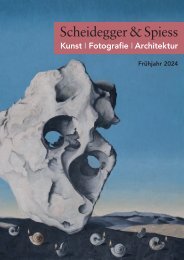Vorschau Scheidegger & Spiess Fruehjahr 2020
Das aktuelle Frühjahrsprogramm mit den Neuerscheinungen des Verlags Scheidegger & Spiess im Bereich Kunst, Fotografie und Architektur!
Das aktuelle Frühjahrsprogramm mit den Neuerscheinungen des Verlags Scheidegger & Spiess im Bereich Kunst, Fotografie und Architektur!
Erfolgreiche ePaper selbst erstellen
Machen Sie aus Ihren PDF Publikationen ein blätterbares Flipbook mit unserer einzigartigen Google optimierten e-Paper Software.
14
12
Keep your nose to the
grindstone
Carole painting
Grande Catalina, 1981
Chrysalis - Detail, 2017
15
13
118 119
96
97
4
46
70
lowres_IMG_0164.
JPG
lowres_Allesandro
Moggi photo of
Carole Feuerman
Magda detail 2.jpg
60 Zaros_99 (2).jpg
5
47
71
Carole A.
FEUERMAN
Fifty Years of Looking Good
Scheidegger & Spiess
(both too numerous to count), the selection aims at decisions made by
Feuerman that, in this friend’s opinion, are revealing of her committed,
deliberate and self-confident way of thinking. Few artists are so closely
identified with their own works as this courageous modern sculptor.
1. In November 1975, Feuerman received a coveted
commission to design a cover for National Lampoon
magazine
Famous for its attention-grabbing covers, the avant-garde Lampoon
knew Feuerman’s designs for record covers and rock concert publicity,
including the Rolling Stones. Since the theme was “Work,” she
illustrated the saying, “Keep your nose to the grindstone.” But rather
than a painting in her usual style, she changed her technique entirely.
The Lampoon cover is a close-up photograph of her first ever lifecast
of a model’s face, realistically painted with spurts of blood. The
graphic impact is exciting, even terrifying. Her willingness to take
such a risk was typical of her fearlessness.
2. The story of Catalina began on a beach in 1977
When Carole Feuerman turned to sculpture in 1978, she took Hyperrealism in a
new direction: she got personal. Photorealism, the term used for paintings, had
made its debut in the 1960s as an off-shoot of Pop Art. Richard Estes’ paintings
of subway cars and Duane Hanson’s sculpture of a supermarket housewife in
curlers were overt satires of junk-food culture. There was an implicit irony in the
idea of a handmade art vaunting the objectivity of photographs. Born in 1945,
Feuerman was a full generation behind Duane Hanson (1925–1996) and a few
years younger than John De Andrea (born 1941), the two sculptors with whom
she ultimately came to comprise the leading trio of American Hyperrealists. Although
Hanson and De Andrea were important 1960s precedents for her realism,
Feuerman’s sculptures reflected her deeper affinity with the sympathetic narratives
of the monochromatic statues by George Segal (1924–2000).
She chose the name of Catalina, because islands represent isolation from
other lands. “When a swimmer submerges into the water they escape the stresses
of the outside world, and they emerge cleansed and invigorated.” The water beads
up on the swimmer’s glowing arms and shoulders, yet Catalina is not about the
Elegante, verträumte Schwimmerinnen:
Carole A. Feuermans lebensechte Figuren begegnen
uns als präzise gefasste Momentaufnahmen
Fifty Years of Looking Good
John T. Spike
In August of 1977, a young, talented illustrator sat down on Jones Beach, Long
Island, to do some thinking. At thirty-two years old, Carole Feuerman was ten
years into an award-winning career as a commercial artist in New York City.
Married and divorced, with three children, she was working day and night to
keep all the pieces together. Now she was also contemplating a major change.
Could she leave illustration behind and begin a new career in the arts, as an independent
sculptor of her own ideas?
Sitting on the beach, she saw a swimmer emerging from the sea, waterdrops
streaming down her face. “She looked proud, like she had just accomplished
something great. With goggles, hair slicked back, I saw her step out of
herself and come into a new reality. Then I figured out how to do it. That woman
gave me the idea to make my first swimmer sculpture, Snorkel.” Three years
later, she made a second swimmer, this time sparing the snorkeling props, and
focusing her attention on the young woman’s radiant, glistening face. She gave
the sculpture the name of an island, Catalina.
Fifty Years of Looking Good is the fourth substantial book about Feuerman’s
career, which has been on a continuous upward trajectory for decades now,
as these copious pages will attest. Her childhood propensity towards art, family
history, schooling, success as an illustrator, and first two decades in sculpture were
admirably described in an essay by Eleanor Munro in her first book, Feuerman
Sculptures, 1999 (2nd rev. ed., 2010). Through the years, Feuerman’s work has
also received attentive interpretations by leading critics such as Robert Kuspit,
John Yau, Peter Frank, David S. Rubin, Stephen C. Foster, Edward Rubin, not to
mention the present writer.
After fifty years it seems right to single out a few “defining moments” in the
career of this important living artist. These moments mostly take place over years:
indeed the last, no. 7 in this list, is still underway. Rather than exhibitions or sales

















